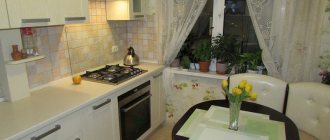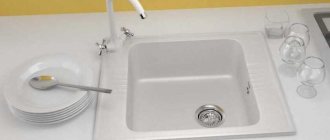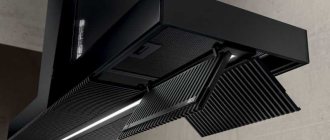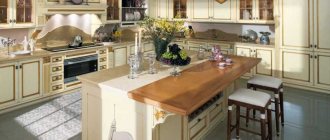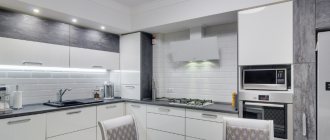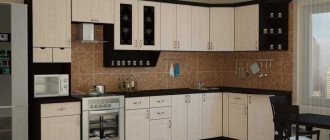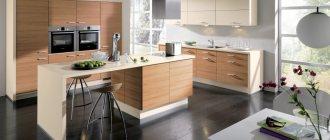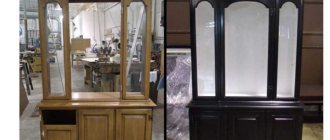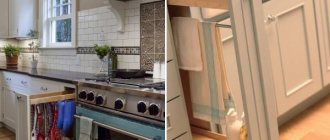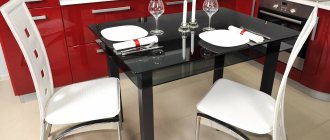Advantages and disadvantages of a kitchen corner sink
The option with a sink in the corner is attractive for several reasons.
Ikea plastic container sets. Advantages over other manufacturers20 paintings for the kitchen in a modern style
Wallpaper for the kitchen - which one to choose 125 photos of amazing design in a modern style
The advantages are:
- space is saved - you can increase the work surface or create a place to store dishes;
- more space appears below - you can put a trash can, household chemicals, and organize the storage of dishes;
- large selection - kitchen sinks in the corner vary in shades, configurations, dimensions, textures;
- a convenient working triangle - you can put a refrigerator on one side and a stove on the other.
Corner kitchen sinks also have disadvantages:
- A dead zone is an empty space in the corner. This can be turned into an advantage if you use the emptiness for household small items, place a dryer or organize shelves.
- Complicated design, this also applies to the cabinet. If it is mortise or integrated, then it is more difficult to install.
- Difficulties during repairs. This problem occurs if the door at the bottom is too small or the communications are hidden.
- Price. An accessory in the corner may cost more than a standard configuration. This applies to a trapezoidal structure or one with 2-3 bowls.
The disadvantages are related to installation and repair, but the need for them rarely arises.
The benefits are valuable every day.
Selecting a sink type
The sink in the corner of the kitchen, as shown in numerous photos, regardless of the type of material, is divided into the following types:
- mortise - fastening occurs directly on the tabletop, which subsequently creates the impression of a recessed structure;
- invoice - installed on the tabletop itself and held on the sides of the structure. As a rule, such a corner sink is purchased in conjunction with a cabinet;
- under-table - the sink is mounted under the countertop.
Types of corner sinks
Tablecloth for the kitchen table - 82 photos of amazing ideas of beauty and practicality- Decoration of a gas pipe in the kitchen: how to hide it without hiding it in the wall? 54 photos of ideas and beautiful solutions
Tiles on the kitchen walls - how to choose and stick correctly? Instructions + 65 photos
They differ in several ways.
This applies to texture, configuration, method of attachment.
Mounting methods
It must be taken into account that the system can be attached in different ways.
According to this criterion, accessories are:
- Invoices. This option is only for the cabinet. There is no need for a tabletop on it, since the entire surface will be covered. You can install overhead structures yourself. They are made with different shapes, dimensions, and shades. There can be 1 or 2 bowls. The overhead system is compatible with any countertops. The downside is that it must be selected strictly according to the dimensions of the cabinet.
- Mortise. You can do the installation of the item yourself. You need to cut a hole of the correct size and shape, and if the edges are uneven, it will be hidden under the edging. The disadvantage of mortise structures is the need for waterproofing. You can use special tape or sealant for this. The mortise item saves space, comes in any shape and size, and has -3 capacities.
- Integrated. They are also called monolithic and are installed when the working surface is made of artificial stone or acrylic. The sink is made from the same material and merges with the countertop. Only a master can do this. Installation is costly, but the integrated item eliminates the development of bacteria and mold fungi.
- Under-table. This design is below the working surface. This option is only suitable for countertops that are not afraid of moisture. The under-table system looks beautiful and is hygienic, but is expensive and difficult to install.
Materials
The choice of material for sanitary ware is determined by the interior design and style of the fittings.
Kitchen sinks are produced:
- Made from stainless steel. Such corner sinks are most often purchased because they fit well into an inexpensive standard kitchen set. Suitable for interiors made in any style, for furniture of different configurations and colors. Advantages: low cost, long service life, ease of operation and cleaning. Matte and glossy stainless steel sinks are produced. Products of the first type are considered to be of higher quality and more profitable: they are more resistant to mechanical stress, the surface is almost not scratched, and a slight dirty coating is hardly noticeable. Glossy sinks are used more carefully. Manufacturers note that their products do not deform when exposed to heat, and do not crack when accidentally hit by washing dishes. Disadvantage: high noise level. A stream of water hitting the surface of a stainless steel makes a strong sound. Dishes that come into contact with steel walls also rattle.
- Made of ceramics. This sink looks attractive, which is why it is always popular with customers. It looks beautiful and expensive in a well-designed kitchen. But attractiveness is the only plus. Ceramics have many disadvantages: heavy weight, difficult installation, low resistance to mechanical stress. Modern manufacturers create sinks from materials that have increased impact resistance. But still, ceramic sinks cannot be called sustainable.
- Made from composite materials: marble or granite chips mixed with acrylic resin. Such sinks are durable, resistant to any impact, do not make noise when washing dishes, and look aesthetically pleasing and attractive. Products are sold in different shapes and colors.
- From stone. Natural and artificial materials are used in production. A marble or granite sink is installed only on an expensive, high-quality set. An ordinary kitchen cabinet will not support the weight of a monolithic product. Such a sink is an addition to an expensive design for mansions and rich apartments. Sinks made of artificial stone do not differ in appearance from natural ones, but their resistance to chemical reagents is lower.
- Made of metal. Enameled steel sinks are a rarity in kitchens today. Such products continue to be produced, but are not popular, since their quality characteristics are noticeably inferior to plumbing fixtures made from other materials. The enamel covering a cast iron or steel surface cracks when exposed to heat, and pieces break off when subjected to strong impacts.
Materials can be combined with each other in plumbing products. For example, sinks made of stainless steel and artificial stone are produced.
Form
If the kitchen has a corner sink, you need to choose the right system configuration.
It should suit the environment and be user-friendly.
The options are as follows:
- Round or oval. The accessory looks compact, but at the same time has a large internal volume. It is functional and takes up little space, which is valuable for small spaces. There are no corners, so dirt and harmful microorganisms do not accumulate.
- Square. This option is also for a small room with a sink in the corner. The square configuration is functional and spacious, suitable for small cabinets and furniture with non-standard depth.
- Rectangular. The bowl can be rectangular or square. In the second case, the remaining space is occupied by an additional bowl or wing. The rectangular shape is attractive due to its spaciousness. The structure can be installed at a corner or straight - with the wing facing the corner.
- Polygonal, including trapezoidal. Such objects are 4-, 5-, or 6-corner and often have an additional bowl. The design itself is polygonal, and the main container has a square or rectangular shape. Such accessories are made from stainless steel or artificial stone. A polygonal structure can have 1-2 wings - it is convenient to place dishes, place a washing sponge, and detergents. The disadvantage is the need for a large cabinet.
- Triangular. These shapes are less popular because the bowl capacity is small. Triangular systems are well suited for small spaces or if you have a dishwasher.
In addition to their outlines, objects differ in the number of bowls.
There may be 1-2 of them, less often 3.
The single-tank system is compact but roomy, suitable for small headsets.
The design with 2-3 bowls is multifunctional - additional space can be used for dishes, defrosting food, washing vegetables.
This is appropriate for headsets of medium and large dimensions.
Basic requirements when selecting a model
The choice of plumbing fixtures most often has an individual character. The corner sink is no exception. But there are general conditions that it must meet.
- Sufficient volume to accommodate dishes;
- Resistance to high temperatures;
- Minimal susceptibility to mechanical damage;
- No reaction to household chemicals;
- Easy to care for.
Corner sink is great for small kitchen spaces
The volume of the bowl is selected depending on the number and dimensions of the dishes. Stainless steel sinks are most resistant to temperature changes; it is difficult to damage a sink made of natural stone. That is, each choice is made based on personal requirements.
Corner sinks with two bowls are becoming increasingly popular.
In addition, the sink must be installed correctly. It is necessary to carefully approach the place where it will be located and the selection of appropriate furniture for it. Once the basic sink requirements have been determined, different types of sinks can be considered.
Corner sink in the interior of a bright kitchen with narrow side cabinets
Expert advice on choosing
The following tips will help you choose a corner sink for your kitchen:
1. Study the photo. This is necessary to decide on the outlines and palette.
2. Consider the dimensions of the headset. A large polygonal design looks bulky on compact furniture, and a small round product gets lost on wide and long work surfaces.
3. Consider the number of users and the presence of a dishwasher. If there is such equipment or a person lives alone, then he does not need a large capacity.
4. If you order new furniture, then it is better to purchase the accessory in the same place. This guarantees a complete match in size and style.
Corner sinks are convenient and appropriate in rooms of any size.
They vary in shape, size, color, and number of containers.
Installation methods also differ - some you can handle yourself.
For convenience, additional accessories are provided - built-in and removable.
